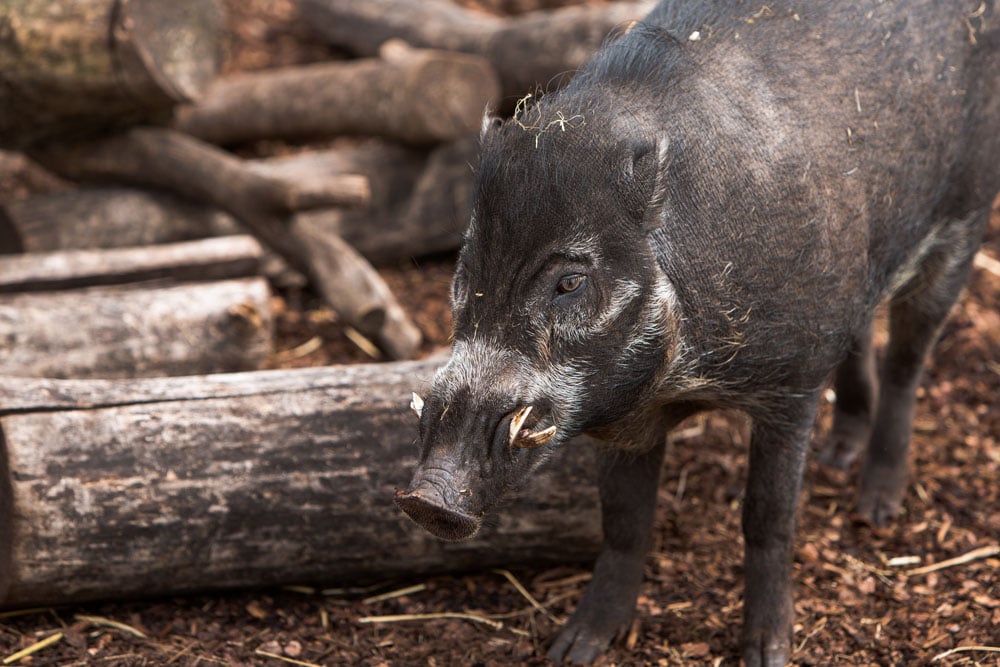How Many Visayan Warty Pigs Are Left
The skin color is dark gray or black. Remaining wild populations are limited to the islands of Panay and Negros.

Cr Visayan Warty Pig Wild Pig Peccary Hippo Specialist Groups
Unfortunately they lost over 95 of their former habitats especially in the lowlands.

How many visayan warty pigs are left. During these unprecedented times were asking for your donations to help pick up the food tab for one day for one of our warty pigs. Because of logging and cultivation of crops such as cane sugar Visayan Warty Pigs have lost the majority of their forest. It is thought that the warts have evolved as a natural defence against rival boars tusks during a fight.
It is known by many names in the region with most translating into wild pig. Both Visayan warty pigs are 18 months old but Mabel is a lot smaller than Malcolm. The species is endemic to six islands in the Visayas group of islands in the Philippines.
Previously found throughout the lush rainforests of. Threats to their existence include habitat destruction population fragmentation persecution as a result of their crop raiding habits and hunting by locals for food. They are however usually found in groups of around five individuals.
It is believed to be extinct in four of the islands in its original native range with only small surviving populations in Negros and Panay. Visayan warty pigs live in groups of four or five. Farmers also see these animals as being a pest therefore they use snares and traps to capture and kill them.
They dine on tubers roots and fruits of the forest but they may also eat cultivated crops. This species requires dense forested areas. The Visayan warty pig is a critically endangered species in the pig genus.
But hunting for both meat and skin has driven the species to extinction in four islands. Only about 300 Visayan warty pigs Sus cebifronsknown for the males distinctive mohawksexist in captivity. Their crop-eating ways have increased in recent years -- about 95 of the pigs forest habitat has been cleared by local farmers who cut down woodlands to plant crops.
The body of males is covered with white hair on the shoulders and sides. The main threat to the Visayan warty pig is deforestation for agriculture. Rare bristly hair covers most of the body it is mostly black in color yellowish-silver bristles often prevail in adult males.
There were 1387 Visayan warty pigs across all EEP-associated zoos in 2015. With a loss of their natural food source many of the. How many warty pigs.
They dine on tubers roots and fruits of the forest but they may also eat cultivated crops. Baboy ihalas baboy talonon and baboy sulop The Visayan warty pig is critically endangered due to habitat loss and hunting. In the wild they only live in small fragmented populations on two Philippine islands.
There are now as few as 200 left in the wild. The Visayan spotted deer Rusa alfredi also known as the Philippine spotted deer or Prince Alfreds deer is a nocturnal and endangered species of deer located primarily in the rainforests of the Visayan islands of Panay and Negros though it once roamed other islands such as Cebu Guimaras Leyte Masbate and SamarIt is one of three endemic deer species in the Philippines although it. Visayan warty pigs are currently extinct on all but two small islands in the Philippines.
Piglets are born in the dry season which extends from January through to March. Current population It is unknown how many Visayan warty pigs are in the wild. This species is becoming very rare in the wild with the other sub species of this pig already believe to be extinct in the wild.
There are so. They are classified the IUCN as a critically endangered species due to hunting and damage to its natural habitat. They follow each other around and appear to be getting on very well with each other.
Visayan warty pigs live in groups of four or five. Shrouded in mystery very little is known about the Visayan Warty Pigs behaviour in the wild. It is endemic to six of the Visayan Islands in the central Philippines.
Their crop-eating ways have increased in recent years -- about 95 of the pigs forest habitat has been cleared by local farmers who cut down woodlands to plant crops. Zoo population There are 200 warty pigs living in zoos across the world. Belfast Zoo hopes that when they reach the right age they will breed and contribute towards the global breeding programme for Visayan warty pigs.
Visayan pigs live in small groups from 4 to 6 individuals. Found in the past throughout the Visayan Islands which is the central archipelago in the Philippines these pigs are now extinct in at least 98 of their former range the few surviving populations concentrated in remaining habitat on the Negros and Panay islands of Negros. These small forest pigs are named for the islands where they are found and for the three pairs of fleshy warts on the male pigs face.
Habitat destruction over hunting for sport reprisals for raids on crops and inadequate protection have resulted in the dramatic decline and likely extinction of the warty pig in the wild. Interesting facts Baby warty pigs are born with stripes to help them blend in to their dense forest habitat. The Visayan warty pig gets its name from fleshy warts on the boars face.
Select How many warty pigs 1 2. Their wild population is unknown. Visayan warty pigs in the wild require dense forested areas as well as grasslands.
Peak Wildlife Park is home to two critically endangered Visayan warty pigs Didi and Siouxsie. One of the most endangered species of wild pig the Visayan warty pig occupies only 5 of its original range.
